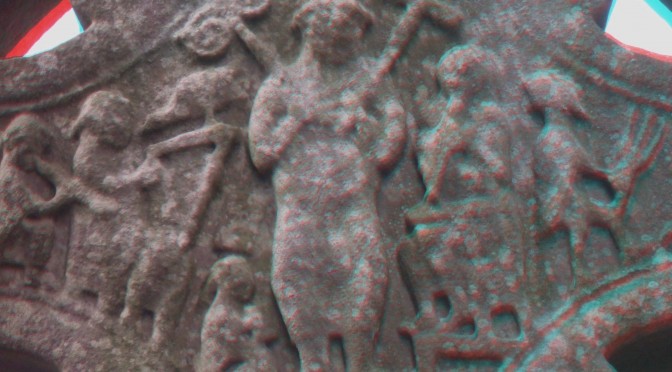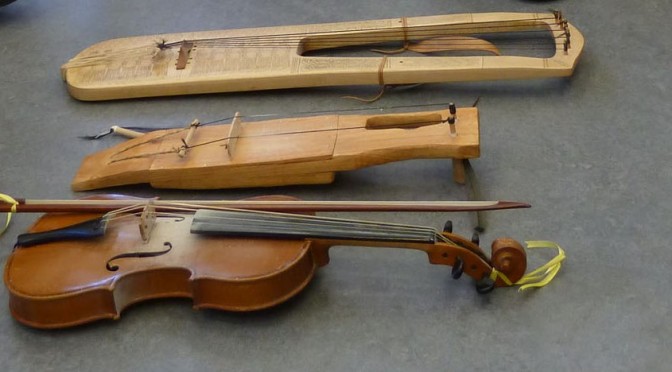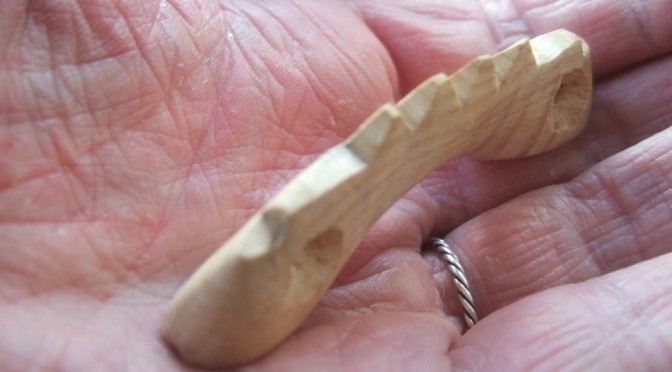On Saturday I was driving south towards Dublin when we spotted the road sign turning to Monasterboice. I zoomed off the motorway and we stopped to look at the amazing high crosses there. I was especially pleased to get a good stereo pair of the carvings on the Cross of Muiredeach.
Tag: lyre
Bowed-harp workshop
Yesterday I was in Edinburgh to present my “bowed lyre workshop” at the Northern Streams festival.
In the Cave of the Picts
Yesterday I packaged up a menagerie of instruments and rode on the train all the way to Elgin, and then out to the coast and down a pretty extreme scramble down the cliff and along over the rocks to the Sculptor’s Cave, on the shore of the Moray Firth. I had been asked to play music in the caves for recording by the European Music Archaeology Project.
One of the caves contains Pictish designs carved on the walls, so I prepared some early medieval repertory and as well as the Queen Mary harp, I took with me the two lyres – the replica Trossingen lyre with horsehair strings, and the early Irish lyre with iron, latten and silver strings and with the Iron Age lyre bridge from Uamh an Ard Achaidh on the Isle of Skye. Also I took the bowed lyre or jouhikko, and the trump or jews harp, and the tambourines, and both my horns – the short early medieval style end-blown horn and the long Bronze-Age style side-blown horn.
The site was beautiful; there was almost no view over to the Black Isle because of the haar, but the sun was shining, the gulls were loud and the archaeological team from Bradford were friendly and working hard on their trenches.
Unfortunately there were serious technical problems with the recording equipment and there were also clashes between access times and train times, forcing me to leave early before high tide cut the caves off, and so in the end I only managed to do a few short takes with the lyres, harp and big horn in one of the caves. Bill Taylor was there as well, and he did some takes in one of the other caves after I had left. All in all, it was fun to play in this venue, and wonderful to spend all day exploring and investigating this powerful and fascinating place.
7 string lyre bridge
My previous reconstructions of the Iron age lyre bridge discovered by archaeologists at Uamh an Ard Achaidh (Skye Pasture Cave) on the Isle of Skye, have interpreted the broken fragment as having only 3 string positions, framed by 4 pyramids along the top of the lyre.
However, it is possible that the flat shoulder on the surviving half of the bridge represents the broken off base of two more pyramids. If this were repeated on the missing other half, that would give a total of eight pyramids with seven string positions.
This week I made a bridge following this plan. I used a piece of yew wood from near St Andrews.
I’ll have both interpretations of the Skye lyre bridge as well as complete student lyres on my Emporium stand at the Edinburgh Harp Festival next week.
Skye lyre bridge
A moonlight photograph of my first copy of the lyre bridge from Uamh an Ard Achaidh (high Pasture Cave).
I have added a page to my Emporium about the lyres now
Irish lyre
I have recently finished setting up an Irish lyre for a customer. This is my own speculative setup. The design is based on a generic Northern European early medieval lyre like the surviving historical instruments from Sutton Hoo in England or Trossingen in Germany, but I have strung and set it up using stringing principles from the historical and mythical Gaelic sources from Scotland and Ireland. The aim is to produce the type of instrument that you can see on the Clonmacnoise high cross, or the type of thing that might be described as cruit or tiompán in early medieval Irish texts.
Following medieval Irish and Scottish Gaelic practice, the strings are made from metal – in this case silver, latten (copper alloy) and soft iron. The instrument is tuned to a hexachord (g-a-b-c-d-e) and has a bright, open voice. The body of this instrument is an inexpensive import, but it is nonetheless a competent piece of work with a hollowed-out maple soundbox and a solid maple soundboard.
For this particular instrument, my customer asked for a reconstruction copy of the Skye lyre bridge fragment, discovered a few years ago in Uamh an Ard Achaidh (High Pasture Cave) on the Isle of Skye in Scotland. This broken lyre bridge dates from the iron age – one thousand years earlier than the surviving English and Continental lyres, but clearly showing the continuity of the lyre tradition in Northern Europe. I carved this bridge entirely by hand from some lovely local figured maple.
If you are interested in commissioning an early Irish lyre, whether an affordable imported student model like this or a full-specification professional model by a British instrument maker, or if you are interested in having a copy of the Uamh an Ard Achaidh lyre bridge, please get in touch with me and we can discuss the options!
Lyre bridge from Uamh an Ard Achaidh
AOC Archaeology have released a laser scan rendering of the lyre bridge from Uamh an Ard Achadh (High Pasture Cave) on Skye. I had already been very interested in this fragment of a musical instrument from the iron age (the original interim report suggests a date of 450 to 550 BC).
Using the rendering, and scaling from the photo in the interim report, I have made a copy or reconstruction of the bridge. As you can see from the photos, the excavated bridge is burnt and broken, with perhaps 1/4 missing from one end. It seems clear to me that the four triangular spikes along the top edge are complete – the gap between the second and third is centered over the carved arch on the underside of the bridge. I confirmed this by cutting out profile views and trying different alignments. This suggests to me that the bridge was for an instrument with three or five strings.
For my bridge I used a piece of sycamore or maple which I had to hand. I made it entirely with hand tools (knives), and finished it by scraping and then sealed the surface with beeswax. Because it is hand carved from a slightly curious piece of wood with some tight flame in the grain, and also because I was only working from the laser scan screenshots not from proper dimensioned plans, it is not an exact replica, but I tried to get it fairly close.
As you can see it works just perfectly. The lyre has six strings, so I just ran the last two together and this does not seem to be a problem. The strings are further apart at the bridge than on other lyres I have seen. The backwards slant of the bridge is curious – unless I am misunderstanding the laser scan, I wonder if it is designed for a much sharper break angle than I am using?
I’ll be playing this lyre at my cathedral concert in the ruins of St Andrews cathedral on Tuesday 5th June at 12.45pm. The music will however be medieval, not iron age!
The Battle of Strathcarron, AD642
This stanza is preserved in the Book of Aneirin, as part of The Gododdin, a cycle of early medieval poetry from Edinburgh and the South of Scotland. This stanza is actually quite seperate from the rest of the poem, and is about a battle that was fought near Glasgow in the year 642. The poem is in the Old Welsh language of the Strathclyde Britons, who were the victors. Domnall Brecc was leader of the South Argyll Gaels, and he was killed by Eugein, grandson of Neithon, king of Strathclyde. This is a highly experimental performance and I apologise for my poor pronunciation and erratic lyre playing.
















